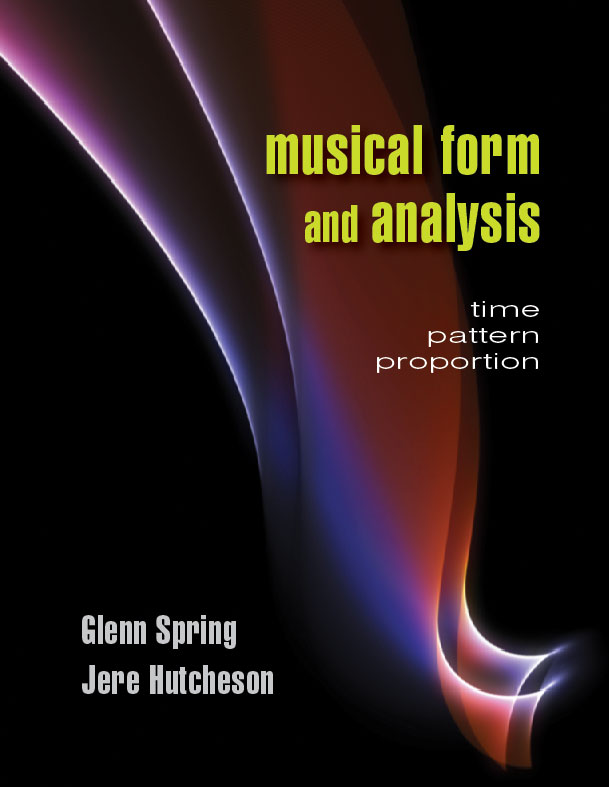“The best Form & Analysis textbook out there!” — Kevin Olson, Utah State University
“An excellent, well-organized text. The musical scores that accompany the chapters are perfectly chosen.” — Stephen Burnaman, Huston-Tillotson University
“The organization of the book is well done and the included examples are, by and large, excellent.” — Frank Felice, Butler University

410 pages, $75.95 list
1-4786-0722-X
978-1-4786-0722-9
© 1995
spiral
eBook availability
Musical Form and Analysis
Time, Pattern, Proportion
Understanding the way music unfolds to the listener is a major key for unlocking the secrets of the composer’s art. Musical Form and Analysis, highly regarded and widely used for two decades, provides a balanced theoretical and philosophical approach that helps upper-level undergraduate music majors understand the structures and constructions of major musical forms. Spring and Hutcheson present all of the standard topics expected in such a text, but their approach offers a unique conceptual thrust that takes readers beyond mere analytical terminology and facts.
Evocative rather than encyclopedic, the text is organized around three elements at work at all levels of music: time, pattern, and proportion. Well-chosen examples and direct, well-crafted assignments reinforce techniques. A 140-page anthology of music for in-depth analysis provides a wide range of carefully selected works.
Evocative rather than encyclopedic, the text is organized around three elements at work at all levels of music: time, pattern, and proportion. Well-chosen examples and direct, well-crafted assignments reinforce techniques. A 140-page anthology of music for in-depth analysis provides a wide range of carefully selected works.
Reactions
PRELUDE: Why Analysis?
Part I: TIME: The Motivating Forces
1. Basic Factors in Form
Rhythm / Melody / Harmony and Tonality / Tension and Relaxation / Articulation of Structural Units
2. The Phrase
General Characteristics / The Additive Process / Phrase Length / The Semiphrase / The Rhythmic Structure of the Phrase / The Harmonic Cadence / The Harmonic Structure of the Phrase / Phrase Extension / Motivic Structure of the Phrase
3. Phrase Groupings
The Two-Phrase Period / Symmetrical and Asymmetrical Periods / Three- and Four-Phrase Periods / The Repeated Period / The Independent Phrase / The Repeated Phrase / The Phrase Group / The Connection of Phrases / Disguised Phrase Endings / Duple Measure Groupings / Description of the Period
Part II: PATTERN: The Shaping Factors
4. The Simple Part Forms
One-Part Form / Two-Part Form / Macrorhythm and Macrotonal Plan / Three-Part Form / Four- and Five-Part Forms / Simple Part Forms as Internal Units / Simple Part Forms in Vocal Music / The Connection of Parts
INTERLUDE: Auxiliary Members
Beginnings / Connections / Conclusions
5. Composite Part Forms
Composite Three-Part Form / Composite Five-Part Form / Composite Part Forms in Vocal Music / Other Composite Part Forms
6. The Rondo
Historical Background / The Classical Rondo: General Characteristics / Treatment of the Principal Theme / The Episodes / The Transition / The Coda / The Five-Part Rondo / The Seven-Part Rondo / Rondo and Part Forms: Similarities and Differences
7. Variation Forms
Theme and Variations / Ostinato Variations
8. Fugue
The Exposition / The Episode / The Middle Entries / The Conclusion / The "Form" of the Fugue / Fugues with Multiple Subjects / Related Types
9. Sonata Form
General Characteristics; Historical Background / The Introduction / The Exposition / The Development / The Recapitulation / The Coda / Sonata Form in the Concerto / Related Forms
Part III: PROPORTION: The Distinguishing Features
10. Multimovement Form
Classical Models / The Concerto: Special Considerations / Cyclical Design / Away from the Classical Model
11. Broader Horizons
Rhythmic Delineation / Parametric Change and Expansion of the Phrase Concept
POSTLUDE: Metaform: Beyond Formal Analysis
The Musical Idea / Musical Character / Proportional Aspects / Under the Magnifying Glass: The Copyist
Anthology: Music for Analysis
Part I: TIME: The Motivating Forces
1. Basic Factors in Form
Rhythm / Melody / Harmony and Tonality / Tension and Relaxation / Articulation of Structural Units
2. The Phrase
General Characteristics / The Additive Process / Phrase Length / The Semiphrase / The Rhythmic Structure of the Phrase / The Harmonic Cadence / The Harmonic Structure of the Phrase / Phrase Extension / Motivic Structure of the Phrase
3. Phrase Groupings
The Two-Phrase Period / Symmetrical and Asymmetrical Periods / Three- and Four-Phrase Periods / The Repeated Period / The Independent Phrase / The Repeated Phrase / The Phrase Group / The Connection of Phrases / Disguised Phrase Endings / Duple Measure Groupings / Description of the Period
Part II: PATTERN: The Shaping Factors
4. The Simple Part Forms
One-Part Form / Two-Part Form / Macrorhythm and Macrotonal Plan / Three-Part Form / Four- and Five-Part Forms / Simple Part Forms as Internal Units / Simple Part Forms in Vocal Music / The Connection of Parts
INTERLUDE: Auxiliary Members
Beginnings / Connections / Conclusions
5. Composite Part Forms
Composite Three-Part Form / Composite Five-Part Form / Composite Part Forms in Vocal Music / Other Composite Part Forms
6. The Rondo
Historical Background / The Classical Rondo: General Characteristics / Treatment of the Principal Theme / The Episodes / The Transition / The Coda / The Five-Part Rondo / The Seven-Part Rondo / Rondo and Part Forms: Similarities and Differences
7. Variation Forms
Theme and Variations / Ostinato Variations
8. Fugue
The Exposition / The Episode / The Middle Entries / The Conclusion / The "Form" of the Fugue / Fugues with Multiple Subjects / Related Types
9. Sonata Form
General Characteristics; Historical Background / The Introduction / The Exposition / The Development / The Recapitulation / The Coda / Sonata Form in the Concerto / Related Forms
Part III: PROPORTION: The Distinguishing Features
10. Multimovement Form
Classical Models / The Concerto: Special Considerations / Cyclical Design / Away from the Classical Model
11. Broader Horizons
Rhythmic Delineation / Parametric Change and Expansion of the Phrase Concept
POSTLUDE: Metaform: Beyond Formal Analysis
The Musical Idea / Musical Character / Proportional Aspects / Under the Magnifying Glass: The Copyist
Anthology: Music for Analysis